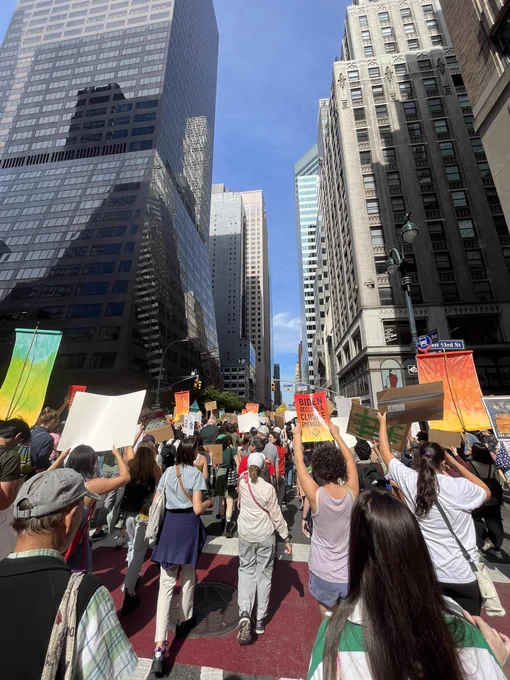There is always a time and place for disruption in the name of climate protest. I truly believe that being loud, angry and unignorable is a legitimate protest tactic; I am all for disrupting particularly unsustainable events and making it impossible to ignore climate protesters. Yes, that includes tennis matches, concerts and rallies. However, these tactics are only effective when the message they are communicating is deliberate and discernible, and the protestors do not garner the rage of people who empathize with their cause by harming someone unrelated to their cause. Coco Gauff cannot end fossil fuels, even if she wants to. Throwing tomatoes at a Van Gogh painting and gluing your feet to the bleachers during the U.S. Open are not what I would call effective or discernable demonstrations. We need climate protesters more than ever. But we need to find a way to be both incredibly irritating to people in power and intentional with the actions we take to sway the general public toward more unified climate action.
Over the last three decades, climate protesters have played an integral role in raising awareness of the looming (and now present) climate crisis. Julia “Butterfly” Hill lived in a tree for over two years to bring global attention to the redwood trees. A Parisian parkour group used their skills to turn off wasteful lights around Paris to bring attention to light pollution and how much people waste valuable energy resources. Cyclists rode onto an airport tarmac to prevent incredibly wasteful private jets from taking off. And most famously, Greta Thunburg’s “Fridays for Future” school strike for climate, whose work has spread globally and inspired youth resistance to widespread climate apathy. Each of these examples are what I would identify as clear in their messaging, deliberate in their actions and discernible from other groups’ activities.
On the other hand, examples of more ineffective protest include people pouring already processed milk onto the floors of grocery stores, thereby irritating customers and employees alike and sending messages so vague that subsequent news outlets had to explain their goals. A similar problem occurred with the tomato soup incident at the British Museum last winter. It was not until news outlets published an explanation that people understood the motives of the protesters, and by then, the protestors were painted as “misguided,” and the message became muddled by outrage.
Unfortunately, I believe the Extinction Rebellion’s demonstration at the U.S. Open Women’s Semifinal falls in the category of shocking but ineffective protests. During the semifinal match between Coco Gauff, now the first American teenager to win the U.S. Open since Serena Williams and Karolina Muchova, several people stood up and began to shout from the stands. The protestors adorned shirts saying “End Fossil Fuels,” and one glued their shoes to the bleachers to make themselves harder to remove. When the NYPD showed up to remove them, the crowd in attendance cheered. The entire event lasted less than an hour, and the game resumed after a roughly 50-minute delay. So, what did they communicate? Honestly, they managed to make some headlines, but Gauff’s own response seems to echo how a lot of people felt about it: “Throughout history, moments like this are definitely defining moments. I believe, you know, in climate change. I don’t really know exactly what … they were protesting. I know it was about the environment. I 100% believe in that. I think there are things we can do better.”
Now, sporting events are great places to demonstrate how wasteful our capital society is. At the U.S. Open, like many sporting events, tiny plastic water bottles were being sold for incredibly high prices and being tossed on the streets outside of the stadium following matches. People attending games are given little choice about the amount of garbage waste they produce, as stadium concessions are limited and eco-friendly packaging hasn’t exactly been a priority. Additionally, stadiums use incredible amounts of energy just to keep their lights on despite usually being massive empty spaces. Stadium events are miniature environmental disasters all on their own.
But what should have been done better? I can’t tell you that in any certain terms. Maybe people should have shamed or irritated the Arthur Ashe Stadium into preemptive measures to reduce energy consumption and a commitment to providing athletes and attendees with sustainable alternatives to disposable plastics. Maybe the Extinction Rebellion should have called out the masses of wealthy celebrities who took private jets to attend matches or attempted to collaborate with them to make meaningful changes to how we operate sporting events. Unfortunately, we don’t know if any of these methods were tried because none of us can honestly believe that the people with the power to make the U.S. Open more sustainable would take the steps to do so.
I cannot stress enough the importance of targeting the parts and people of society who are producing the greatest carbon emissions. Do I think the Extinction Rebellion demonstration was trying to do that? Kind of. Do I think they communicated it well? No. I agree that no one should have a private jet, no matter who they are or how important they think they are. No stadium should continue its wasteful habits. And everything that goes into major sporting events is inherently wasteful. We should end the use of fossil fuels. But I also recognize that people doing incredible things deserve a moment in the sun — as in the case of Gauff. She deserved her moment. Taking away a moment of celebration from someone who has worked incredibly hard to get where they are is not going to sway people toward a cause, no matter how good that cause may be.
Although I fully stand beside the motives for these actions, their vague messaging through seemingly random acts of resistance leads people to question the seriousness of these climate activist groups. Shock has value in protest, and it is undeniable that throwing tomato soup at a beloved painting or gluing yourself to bleachers during the U.S. Open is shocking. I am all for meaningful destruction and disruption, but when people cannot easily identify the meaning or understand the motive, the message is easily corrupted to sew a narrative against climate action.
Alexandra Rapp, FCRH ’24, is a history and international studies major from Hershey, Pa.









































































































































































































